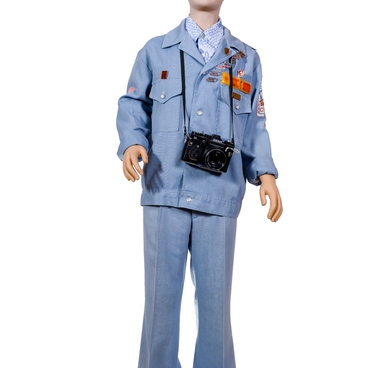Reel-to-reel tape recorders “Aidas” or “Elfa-20” were produced at the Vilnius Electrotechnical Works “Elfa” from 1962 to 1966. The name “Aidas” means “echo” in Lithuanian.
Such tape recorders allowed people not only to listen to music or radio programs but also record melodies and voices through a built-in microphone.
The museum houses the device with its case made of metal and covered with artificial leatherette. There are decorative grilles on the front and back panels and a carrying handle on the side. The top cover of the recorder is removable and reveals the microphone for sound recording, as well as the tape drive mechanism, next to which are the power, tone, and volume knobs. There is also a jack for the button that locked the record key and prevented accidental erasure of the soundtrack. The button itself has not survived.
The plastic panel with the microphone jack and the power cord occupies the left side of the case.
To start, the Aidas tape recorder should be placed horizontally, plugged into a socket, and pressed the “stop” button. Then the volume knob should be turned clockwise until it clicked, then the indicator light would illuminate, indicating that the tape recorder is ready for use. The left spool holder was for the tape reel and the right one was for the empty reel. When the tape recorder was running, the tape was rewound from one reel to the other, sometimes with the working layer on the inside, so that the tape could not be mistakenly started from the end.
Reels in the Soviet Union were distinguished by “numbers”, which means the outer diameter in centimeters. The battery-powered models usually had No. 10 and No. 13 reels, with No. 15 being the most popular option for corded models. These are exactly the reels used in the Aidas model.
In 1966, the Aidas tape recorders were improved by replacing the tape drive mechanism and electrical circuitry. The updated model was produced as “Aidas-9M”.
The reel tape recorders were popular in the USSR until the 1980s. Then more compact, lightweight, and easy-to-operate cassette models gradually replaced them.
Such tape recorders allowed people not only to listen to music or radio programs but also record melodies and voices through a built-in microphone.
The museum houses the device with its case made of metal and covered with artificial leatherette. There are decorative grilles on the front and back panels and a carrying handle on the side. The top cover of the recorder is removable and reveals the microphone for sound recording, as well as the tape drive mechanism, next to which are the power, tone, and volume knobs. There is also a jack for the button that locked the record key and prevented accidental erasure of the soundtrack. The button itself has not survived.
The plastic panel with the microphone jack and the power cord occupies the left side of the case.
To start, the Aidas tape recorder should be placed horizontally, plugged into a socket, and pressed the “stop” button. Then the volume knob should be turned clockwise until it clicked, then the indicator light would illuminate, indicating that the tape recorder is ready for use. The left spool holder was for the tape reel and the right one was for the empty reel. When the tape recorder was running, the tape was rewound from one reel to the other, sometimes with the working layer on the inside, so that the tape could not be mistakenly started from the end.
Reels in the Soviet Union were distinguished by “numbers”, which means the outer diameter in centimeters. The battery-powered models usually had No. 10 and No. 13 reels, with No. 15 being the most popular option for corded models. These are exactly the reels used in the Aidas model.
In 1966, the Aidas tape recorders were improved by replacing the tape drive mechanism and electrical circuitry. The updated model was produced as “Aidas-9M”.
The reel tape recorders were popular in the USSR until the 1980s. Then more compact, lightweight, and easy-to-operate cassette models gradually replaced them.



